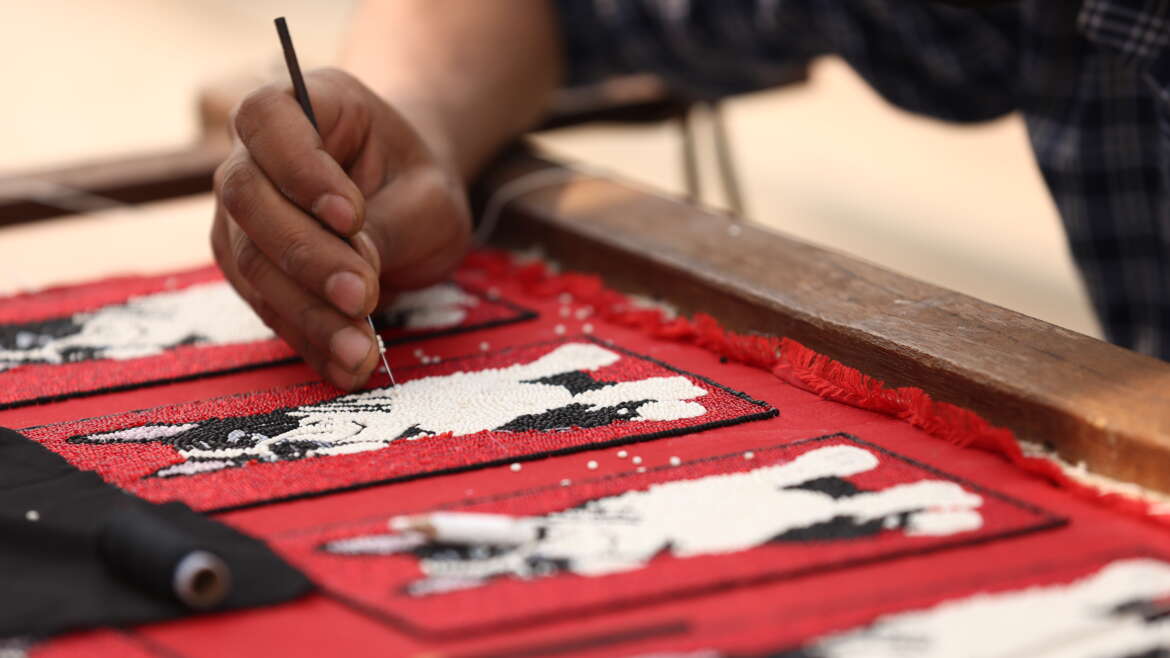The simple yet fascinating art on handbags, suits, and the heavy bride’s dress has always been a center of attraction. Embroidery can be simply defined as a story embedded on a piece of material using a needle and thread in different colors. What spices do with a dish, the embroidery does the same with the fabric gives it colors and enhances the beauty. When we talk about Indian embroidery, it is determined in two terms ‘zardosi’’, “Aari” also known as “Adda”.
Adda embroidery has its earliest mention in the Vedic period. It uses a needle with a sharp pointy hook at the end, the earliest needles were excavated from Mohenjo-Daro(now Pakistan).
How does it work?
It uses a different type of silk, thread, and metallic thread to arrange sequence and beads on the material to fill it with embroidery. The pointy hook needle makes the aari work easier and faster in comparison to the zardosi thread needle. It does not need to cut a new thread or tie a knot as the thread can be used directly from the spool.
Now a question may arise in your mind that all these techniques are okay, but what does adda mean? Adda is the wooden frame in which the fabric is held (stitched) and is stretched apart to avoid wrinkles or folds on the fabric. The parallel wooden bars are tightly locked to continue the further needlework. Necessary tools and material for aada are:-
- Adda(wooden frame)
- Aari(point hooked needle)
- Thimble
- Scissors
- thread(gold or silver), metal thread
- Embroidery threads
- Beads or other embroidery charms(stones)
How many industries does it affect?
Our embroidery work is unique and classy in its own way, not only Indians believe this even the intruders and businesses from different ends of the globe have accepted it. Mughals were so fascinated with Indian embroidery that there were special workshops in the area for all types of craft. But with time, and western influence the demand for craft decreased, and it led to the exploitation of artisans. Later the call to preserve the ancient art was heard and many steps were taken by the government and private companies to promote the art and artisans.
The fusion of ancient Indian craft with trendy fashion is the most classy, cultural, and demanding fusion at present. Now the art does not limit itself to the fabric or clothes, everything you use can be made more delightful with this art. Other than the garment industry, accessories like handbags, home decors like curtains, bed sheets, wall hangings, and cover clothes for tables and other objects are the common sectors where embroidery has its essence.
How many families are supported with this work?
Adda embroidery has been in the roots for decades, and it is passed to the next generations from the older one. India is a nation of diversity, and so is its art “diverse”. Here every state has its own colors and art, and this increases the participation of the artisans.
As per the official record, there are more than 7 million artisans currently working in the craft sector. This adds value to the economy of the country and their own and also increases the aura of the craft. 7 million is the official count, but several families design at their home and sell it through social media. Including them, the number of working artisans grows to 200 million. This empowers women, and they are proudly getting recognized through their art. With fame, it is also supporting them financially.
Just close your eyes and think of embroidery the vibrant colors from different states fill the mind. Right? The complex Gujarati fabric art, or the red and yellow craft on the clothes in the desert and it goes on and on in every state. And how the heavy soothing bride’s gown (lehenga) can skip from our thoughts.

